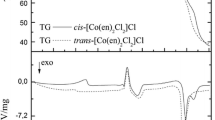Abstract
The conformational analysis of (CH3)2SO is investigated within the framework of the CNDO/2 approximation. The preferred conformation of heavy atoms (C, S, O) is found to be the one (r OIV) which was proposed by Dreizler et al. in 1969 on the basis of microwave measurements. The map of isoenergy curves was drawn, describing the variation of energy as a result of mutual rotation of the two methyl groups. This showed that the equilibrium symmetry for the complete molecule, including the hydrogens, was C sHowever, it may be noticed that the two hydrogens which, for the (60, 60) conformation, would have been located into the CSC plane, are actually staggered of 3.64° out of this plane and nearer to the oxygen atom than to the sulphur lone pair. The rotational barrier for one CH3 group is 3.5 kcal/mole, in agreement with the experimental value (2.8 kcal/mole [7]). A bicentric energy partitioning shows that about 60% of the variation in total energy is reflected by the single sum, ΣE(S...H), of the spatial interaction terms between sulphur and the six hydrogens.
Résumé
La méthode SCF-LCAO-MO dans l'approximation CNDO/2 est utilisée pour l'étude de l'analyse conformationnelle du diméthylsulfoxyde (CH3)2SO. On montre ainsi que, parmi les déterminations géométriques de la littérature, celle (r OIV) obtenue par Dreizler et Coll. en 1969 au moyen de la spectroscopie de microondes semble devoir être retenue. La carte de potentiel, décrivant la rotation simultanée des deux groupements méthyle autour des liaisons (S-C), est tracée: elle montre que la molécule (CH3)2SO appartient bien au groupe de symétrie C s, non seulement au niveau des atomes lourds (C, S, O) mais aussi à celui des hydrogènes. On note toutefois que les deux hydrogènes qui, dans la conformation (60, 60), auraient été dans le plan CSC, sont alors décalés tous deux de quelque 3,64° hors de ce plan et du côté de l'atome d'oxygène. La barrière à la rotation d'un CH3 est trouvée égale à 3,5 kcal/mole (expérimentalement: 2,8 kcal/mole [7]). Un découpage bicentrique de l'énergie totale montre enfin que 60% des variations de cette grandeur sont dûs à la seule somme, ΣE (S...H) des interactions dans l'espace entre l'atome de soufre et les six atomes d'hydrogène.
Zusammenfassung
Die Konformation von (CH3)2SO wird im Rahmen des CNDO/2-Verfahrens analysiert, wobei sich für C-, S- und O-Atome das gleiche Ergebnis wie bei Mikrowellenmessungen (Dreizler, 1969) ergibt. Ferner wird die Energiehyperfläche für Methyl-Rotationen angegeben, mit der Symmetrie C sam tiefsten Punkt. Allerdings sind die zwei H-Atome, die bei der (60, 60)-Konformation in der CSC-Ebene liegen sollten, um 3,64° aus dieser Ebene herausgedreht und näher an den einsamen Elektronen des Sauerstoffs als an denen des Schwefels. Die Rotationsbarriere einer CH3-Gruppe beträgt 3,5 kcal/ Mol (experimentell 2,8 kcal/Mol [7]). Eine Energieaufspaltung auf Zentrenpaare zeigt, daß etwa 60% der Änderung der Gesamtenergie in der Einfachsumme ΣE(S...H) der räumlichen Wechselwirkungs-systeme zwischen den S- und den sechs H-Atomen enthalten ist.
Similar content being viewed by others
Bibliographie
Pople,J.A., Segal,G.A.: J. chem. Physics 44, 3289 (1966).
Robinet,G., Crasnier,F., Labarre,J.-F., Leibovici,C.: Theoret. chim. Acta (Berl.) 25, 259 (1972).
Labarre,J.-F., Leibovici,C.: Int. J. quant. Chemistry sous presse (1972) (F3P·BH3 et F2HP·BH3).
— —: J. Chim. physique 68, 1618 (1971) (F3NO).
— —: J. Chim. physique 69, 404 (1972) (H3B·CO).
Dreizler,H., Dendl,G.: Z. Naturforsch. 19a, 512 (1964).
Feder,W., Dreizler,H., Rudolph,H.D., Typke,V.: Z. Naturforsch. 24a, 266 (1969).
Viswamitra,M.A., Kannan,K.K.: Nature 209, 1016 (1966).
Thomas,R., Shoemaker,C.B., Eriks,K.: Acta crystallogr. 21, 12 (1966).
Bastiansen,O., Viervoll,H.: Acta chem. scand. 2, 702 (1948).
Wiberg,K.: Tetrahedron 24, 1083 (1968).
Robinet, G., Leibovici,C., Labarre,J.-F.: Chem. Physics Letters, sous presse (1972).
Author information
Authors and Affiliations
Rights and permissions
About this article
Cite this article
Robinet, G., Leibovici, C. & Labarre, J.F. Analyse conformationnelle théorique du diméthylsulfoxyde (CH3)2SO. Theoret. Chim. Acta 26, 257–265 (1972). https://doi.org/10.1007/BF00529311
Received:
Issue Date:
DOI: https://doi.org/10.1007/BF00529311




